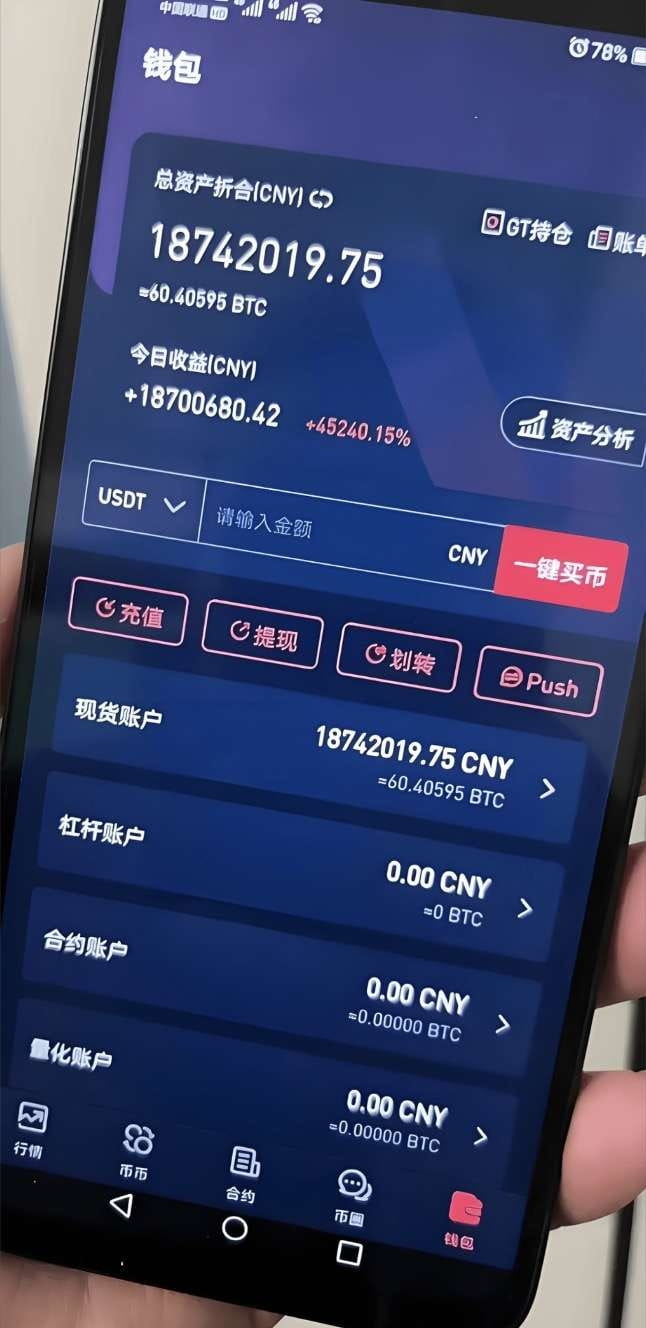I can be considered one of the earliest Bitcoin players in China; I started promoting Bitcoin in 2011, but I got off the ride early after a short time. I later dabbled in altcoins and made some small profits!
At my peak, I owned four-digit amounts of Bitcoin!
If I had held on until now, it would be worth close to ten digits in RMB.
But most of them sold after making dozens of times, although there’s still a fraction left unsold; the reason for not selling is simple, the fraction is too small to care about, so it has been left on the exchange without management.
But even if it's just a fraction, it's still hundreds of Bitcoin.
Or to put it more bluntly, the Bitcoin fraction that I initially looked down on is now approaching nine-digit RMB.
Trading in progress...

Analysis of diverse profit strategies in the crypto world and risk guidelines:
The cryptocurrency market is full of opportunities and challenges; mastering scientific strategies is essential to seize profits amid volatility. Below are mainstream profit strategies suitable for investors with different risk preferences:
1. Stable investment strategies
1. Long-term holding (HODL)
Core concept: Relying on the time compounding effect, profit through capturing the long-term value growth of mainstream coins like Bitcoin and Ethereum.
Key operation points: Select fundamentally sound cryptocurrencies, ignore short-term fluctuations, and the holding period is recommended to be 3-5 years.
2. Regular investment (dollar-cost averaging)
Strategy logic: Enter in batches at fixed intervals (weekly/monthly) and fixed amounts, smoothing the impact of price fluctuations and reducing the average cost.
Suitable for people: New investors with little time to monitor and low risk tolerance.
3. Grid trading method
Operating mechanism: Automatically place buy and sell orders within a set price range at fixed price differences to accumulate profits through high-frequency small transactions.
Technical requirements: Need to plan grid spacing and fund allocation in advance, suitable for trading in volatile markets.
2. Technical trading strategies
1. Moving average trading system
Indicator application: Use short-term moving averages (like the 5-day line) crossing above/below long-term moving averages (like the 20-day line) as buy/sell signals.
Optimization points: Combine transaction volume, MACD, and other indicators to filter out false signals and reduce misjudgment risks.
2. AI quantitative trading
Technical advantages: Use machine learning algorithms for high-frequency trading to avoid human weaknesses and achieve 24-hour automated operations.
Implementation threshold: Programming skills or using professional quantitative platforms are required, paying attention to algorithm model backtesting and optimization.
3. Risk arbitrage strategies
1. Bull market dip buying strategy
Timing of operations: In a bull market, capture short-term rebound opportunities in altcoins, focusing on coins in the top 50 by market capitalization with technological innovations.
Risk control: Set strict stop-loss levels; no single investment should exceed 10% of the total position.
2. Pyramid bottom-fishing method
Fund allocation: For every certain percentage drop in price, increase the buy-in according to a 1:2:3 ratio to gradually dilute costs.
Applicable scenarios: Suitable for the end of a bear market or after a black swan event’s sharp decline.
4. Project participation strategy
1. Token issuance financing (ICO/IDO)
Participation method: Subscribe to new tokens through the primary market and profit from the price premium during the initial listing.
Risk warning: In-depth research on project white papers and team backgrounds is required, beware of air coins and exit risks.
2. Airdrops and platform benefits
Source of income: Participate in exchange activities (like Binance Alpha) and complete social tasks to obtain free tokens.
Key operation points: Pay attention to official channel information, avoid participating in unverified fraudulent airdrops.
5. Miner's profit model
1. Proof of Work (POW) mining
Cost composition: Consider the costs of purchasing mining machines, electricity expenses, and site maintenance; currently only suitable for low electricity price areas.
Technical upgrade: Some miners are turning to staking mining (PoS) after Ethereum's merge.
2. New coin mining
Opportunity digging: Acquire low-priced chips by pre-positioning new coins for genesis mining.
Risk control: Focus on assessing project tokenomics and community development potential.
Risk warning
1. Policy risk: The global regulatory environment continues to tighten, and some countries have already banned cryptocurrency trading.
2. Market risk: Cryptocurrency prices are highly volatile, with daily declines exceeding 30% being a common phenomenon.
3. Technical risks: Frequent security incidents like smart contract vulnerabilities and wallet theft.
Investors are advised to adopt a combination investment strategy based on their risk tolerance and strictly implement fund management and stop-loss plans.
The cryptocurrency market is highly uncertain; be sure to fully understand the relevant knowledge before participating and never blindly follow the crowd to invest.

This market keeps repeating the same secret: 90% of the retail traders focus on news to trade cryptocurrencies, 9% of smart people focus on the movements of the main forces, while 1% of wolf-like players dissect the market genes with daily moving averages.
Step one: Verify the moving averages.
Treat the daily moving averages as three doctors with distinct personalities— the 5-day line is the emergency department chief, the 30-day line is the internal medicine expert, and the 60-day line is like a senior doctor sitting in a specialist clinic. When the emergency chief suddenly perks up and goes to check the pulses of the two esteemed seniors (5-day line crossing above the 30/60-day line), that is a signal that the market is preparing to enter the ICU for rescue. Conversely, if you find the emergency chief slipping and rolling down from the senior doctor's chair (5-day line crossing below the 30/60-day lines), don't hesitate; immediately adjust your position.
Step two: Establish a trading system to prevent emotional trading
Now, please stick a note on your trading interface, written in bold marker: When moving averages clash, ordinary people retreat. When the 5-day line and 30-day line are intertwined like twisted dough, rushing in is like rolling dice to guess odd or even. True hunters only pull the trigger when all three lines march in the same direction.
Here’s a counterintuitive cold fact: In the crypto world where extreme volatility is the norm, the daily average line strategy becomes deadlier the simpler it is. Just like true martial arts masters don’t use fifty opening moves, a 5-day line breakout is the signal to draw your sword, while a 60-day line turning is the right time to sheathe it.
Step three: Lock discipline in at the trading desk
I’ve seen too many people write their trading plans on napkins, only to be scared into tearing the napkin apart when they get spooked by a sudden price spike in the middle of the night. The most brutal yet merciful aspect of the daily average line strategy is that it forces you to become an emotionless signal execution machine.
Here’s a bit of dark humor: A trader who stabilized profits using daily average line strategies for three years received a 5-day line breakout warning during a wedding ceremony and had to hide in the bathroom to close their position before coming out to exchange rings. Afterward, the bride scolded him, but after seeing the account balance, silently got him a top-tier monitor.
(Carve this sentence into your brain: You can doubt your operations, but never doubt the moving averages that have formed synergy.)

1000U Comeback Guide: The ultimate strategy for small capital
Still complaining about your small capital? Wake up! Blowing up an account is never due to having little money but because you don't know how to play. This method enabled me to roll from 1000U to over ten thousand; now I’ll teach you to replicate it step by step!
Stage one: Survival development (1000→3000U)
💰 Operational iron rules:
Single bet ≤ 300U (30% position)
Stop loss immediately at 15U loss (5% stop-loss line)
Withdraw the principal immediately after making a profit
(This way, you can quickly enter a 'profit-playing' stress-free state)
Stage two: Violent rolling positions (3000→10000U)
🚀 Four military regulations:
Only increase positions when profitable (adding to losses is a sure way to death).
Leverage reduction: 5x → 3x → 2x
Floating profits must raise stop-loss
Only take action in unilateral markets (play dead in sideways markets)
🔥 Real case examples:
BTC 60,000 open 5 times long (900U)
→ 62,000 plus 3 times (600U)
→ 65,000 plus 2 times (500U)
→ 70,000 take profit (profits far exceed holding it forever)
Deadly trap checklist
💀 Gambling feels good for a moment, but blowing up your account feels like a funeral.
💀 No stop-loss? Just wait for a one-click return to zero.
💀 Frequent trading = Giving money to the exchange
💀 Earn a little and run? You'll never get the big gains.
Ultimate secrets for small capital
Discipline > Technology
Risk control > Return
Missing out > Making mistakes
(A heartbreaking statement: If you can't handle 1000U well, giving you 100,000U is just a gift.)
Remember: small capital is the market's most flexible 'special forces.' Want to see my real trading operations? First, prove that you can strictly follow this set of methods. The market never lacks opportunities; it lacks those who can survive until opportunities arise.
If you're doubting life due to losses in crypto trading right now, spending 3 minutes reading this may help you survive.
In my first three years, I doubted life after blowing up my account, with debts of 8 million and almost jumped off a building. Now? Hehe, making a million a month feels like play. Today, I’m going to share my ultimate trading principles with you.
Remember this twelve-character motto: Cut losses quickly, hold on if right, small losses and big gains. How to play specifically?
1. Look at the trend.
When the 5-day line is above, only go long; when it's below, only go short. Don't go against the trend; it will end badly.
2. Trial trades
Find those positions where the stop-loss is only 1 dollar, but can multiply tenfold when earning. Usually at the bottom when the market has just started, if wrong, you only lose the cost of a meal.
3. Quick cutting of losses
Cut losses immediately if key levels are broken; don’t fall in love with your positions. If the market rebounds after you cut, then reenter; it's better than blowing up your account.
4. Increasing positions is the way to go.
After making your first wave of profits, wait for a pullback to the support level before increasing your position. Remember: increasing your position should be as cautious as making your first trade.
5. Moving stop-loss
Each time you increase your position, raise the stop-loss accordingly. This way, in the end, you only have profits running, and you can sleep well.
6. Let profits fly
Don't act like you've never seen money; making 10% and running is foolish. The real gains are yet to come; wait for clear topping signals before dumping everything.
These six points seem simple, but 90% of people fail in execution. If you can hold back, making money is just a matter of time. When I understood this point, my account balance started to soar like a rocket. Now it's your turn.

Iron laws for survival in the crypto world: The 'dumber' you are, the more you earn; 90% of people fall on the 'smart' road.
After years of struggling in the crypto world, I’ve seen too many people blow up their accounts and lose everything. In fact, most people don’t lose due to the market, but rather fall to their own 'smartness'—always looking for shortcuts and ignoring the simplest 'dumb methods.' Today, I will unveil the truth of survival in the crypto world. Only those who can grasp it can truly survive and make money.
1. 90% of people fall to these three fatal mistakes
(1) Buying high and selling low, reverse trading
When the price of the coin rises, you chase it in greed, fantasizing about 'lying back and earning,' but end up crashing as soon as you buy; however, when true panic-selling occurs and the bottom appears, you get too scared to enter the market. Remember: Only those who can turn 'buying the dip' into muscle memory can truly capitalize on cyclical benefits. When others panic, you must be greedy to catch the real bottom.
(2) Holding onto positions stubbornly, risking it all
Thinking that once you firmly choose a direction, you can 'go all in and get rich,' but when the main force slightly shakes a few needles and creates some fluctuations, you get washed out. The crypto world has never had a 'guaranteed profit' unilateral trend; stubbornly holding a position only hands over the initiative to the market. True experts know how to respond flexibly; if the trend is wrong, cut it; don’t fight the market stubbornly.
(3) Fully invested without a fallback
When emotions rise, going all in means you might miss better entry points due to lack of bullets, even if your trend guess is correct; once the market reverses, you could face total liquidation. Remember: Opportunities in the crypto world are always there; keep your bullets to maintain initiative. Going all in is gambling, not investing.
2. The 'six-character mantra' ignored by 90% of people is the most effective the 'dumber' it is.
(1) Before a reversal, don’t act blindly
"High position consolidation is not over, new highs are still ahead; low position sideways has no bottom, easily creating new lows." During market fluctuations, most people lose patience and frequently operate, resulting in being slapped in the face repeatedly. Remember: before a reversal signal appears, holding back is winning; it's better to miss out than to make a wrong move.
(2) In sideways periods, endure.
"Do not enter the field during sideways movements." Sideways markets are traps where the main forces wear you down; the more you can’t hold on, the easier it is to cut losses at the bottom and chase highs at the top. True experts observe and wait during sideways periods, holding out until the reversal point to act, which maximizes their win rates.
(3) Go with the sentiment, follow the daily line
"Buy on a bearish daily close, sell on a bullish close." Don't blindly trust your 'market sense'; market sentiment lies hidden in the K-line. A bearish line represents panic, which is a buying opportunity; a bullish line represents euphoria, which is suitable for taking profits and exiting. Following market sentiment is 100 times more reliable than making decisions on a whim.
(4) Watch the rhythm, catch the rebound.
"Slow declines bounce low; fast declines bounce high." Market rhythm determines opportunity: Don't bottom fish in a slow decline; the slower the drop, the more pressure remains, making big rebounds unlikely; quick drops hide opportunities, panic selling creates golden pits, and there are often rapid rebounds after quick drops. Understanding the rhythm is key to seizing opportunities.
(5) Pyramid, leave room to maneuver
"Pyramid-style building, entering in batches." Never go all in at once; in a downtrend, buy in batches at lower prices; in an uptrend, take profits in batches. Keep your bullets for sudden market movements; true experts always leave themselves room to maneuver.
(6) After big rises and falls, wait for signals
"After big rises and falls, there must be consolidation, and after consolidation, there will definitely be a change." After extreme market fluctuations, don't rush to go all in or cut losses; the consolidation period is the "power-up period" for bulls and bears to compete; wait for the reversal signal (breaking key resistance/support levels) before acting, and your win rate and returns will double.
3. The truth about survival in the crypto world: Only those who can endure will make money.
The market never lacks opportunities; what it lacks are people who can 'stay steady, endure, and survive.' Don't envy the experts for their 'good luck'; they have merely perfected these 'simple methods'—using patience to combat volatility, using discipline to control risks, and using strategies to seize opportunities.
Remember: In the crypto world, it's not 'smart money' that earns, but 'dumb effort.' If you can grasp these iron laws, hold back, endure, and execute steadily, your path in crypto trading will only widen, from being a harvested 'chives' to a meat-eating 'hunter.'
Finally, a reminder: The crypto world has risks; operations must be cautious. But as long as you master these 'dumb methods,' you can stand firm in the market.
